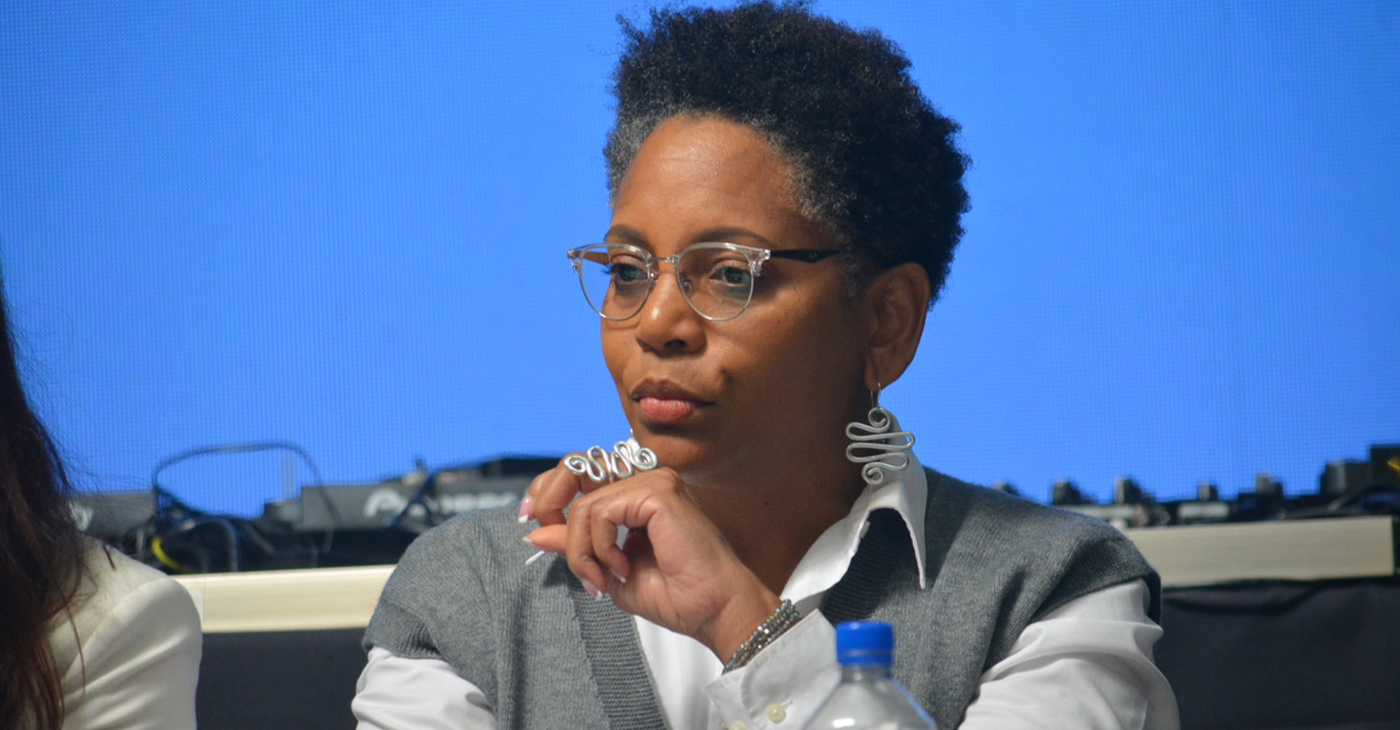Antonio Ray Harvey
Working Group: More Entry-Level Homes Could Help Solve Housing Crisis
The Community Housing Working Group hosted a briefing on April 23 at Cafeteria 15L in Sacramento. Discussions focused on how the housing crisis in California affects Black and Brown communities and explored ways to provide low-income families and individuals with affordable housing.

By Antonio Ray Harvey, California Black Media
The Community Housing Working Group hosted a briefing on April 23 at Cafeteria 15L in Sacramento. Discussions focused on how the housing crisis in California affects Black and Brown communities and explored ways to provide low-income families and individuals with affordable housing.
Tia Boatman Patterson, CEO and President of the California Communities Reinvestment Corporation, said “entry-level housing” is not available as it was in the past, adding that affordable units were a major point of entry into homeownership for many families in the Black community.
“My mother bought her first house when I was in junior high. It was an 850-square foot, two-bedroom and one-bathroom house in 1978. That house cost $30,000,” Boatman-Patterson said.
“A woman working part-time at JCPenney was able to afford that house. We don’t build these types of housing now. We do not build entry-level homeownership,” she added.
The Community Housing Working Group is a collection of diverse community organizations from across California working together to address housing challenges in their communities. The organization believes that solving the affordable housing crisis will require creating enough smaller, lower-cost, multi-family homes located near jobs, transit, and good schools.
The briefing included a panel discussion titled, “Exclusionary Zoning: A Look Back and a Path Forward.” Boatman-Patterson participated in that session along with Henry “Hank” Levy, Treasurer-Tax Collector for Alameda County, and Noerena Limón, consultant, Unidos U.S., and Board Member of California Housing Finance Agency.
Boatman-Patterson, a former Associate Director for Housing, Treasury and Commerce in the Office of Management and Budget for the Biden Administration, started her presentation by highlighting how exclusionary single-family zoning is contributing to continued segregation of California communities.
She said that single-family zoning originated in the Bay Area city of Berkeley in 1916.
“By creating single-family zoning and having fenced-off communities, you were able to exclude the ‘others,’” Boatman-Patterson said. “It really was a method to exclude — what they called ‘economic segregation’ — but that was a guise for racial segregation. Single-family zoning, along with redlining, became a systemic approach to exclude based on affordability.”
Title VIII of the federal Civil Rights Act of 1968 — commonly known as the Fair Housing Act of 1968 – is the U.S. federal legislation that protects individuals and families from discrimination in the sale, rental, and financing of housing. It was passed to open the doors to affordable housing.
In 1968, 65.9% of White families were homeowners, a rate that was 25% higher than the 41.1% of Black families that owned their homes, according to National Low-Income Housing Coalition. Today, those figures have hardly changed in the Black community, although White homeownership has increased five percentage points to 71.1%.
Boatman Patterson said the rate has not changed in Black and Brown communities because financing for affordable entry-level homes is almost nonexistent. The homeownership disparities contribute to the disturbing racial wealth gap in the nation, according to the National Low-Income Housing Coalition’s October 2018 report.
“We really must align the financing with the actual building of units, which we haven’t necessarily done. Because of this misalignment, I think we continue to see problems,” Boatman-Patterson said.
Activism
Childhood Literacy Bill Supported by NAACP and CTA Moves Closer to Becoming California Law
“This legislation is essential, important progress, and it reflects agreement and robust consensus on ways to provide educators the evidence-based tools they need to support California’s diverse students,” Rivas said in an April 30 statement. “We must make sure every child, no matter their background, has the opportunity to become a confident and thriving reader.”

By Antonio Ray Harvey, California Black Media
The Assembly Committee on Education passed previously stalled legislation after an agreement was struck to strengthen early childhood literacy efforts in the state by equipping educators with the necessary tools and training.
Assembly Bill (AB) 1454, authored by Speaker Robert Rivas (D-Hollister), Assemblymember Al Muratsuchi (D-Torrance), and Assemblymember Blanca Rubio (D-Baldwin Park), unanimously passed out of committee with a 9-0 vote.
The evidence-based reading instruction bill, supported by the National Association for the Advancement of Colored People (NAACP) California-Hawaii State Conference, now moves on to the Committee on Appropriations for review.
“This legislation is essential, important progress, and it reflects agreement and robust consensus on ways to provide educators the evidence-based tools they need to support California’s diverse students,” Rivas said in an April 30 statement. “We must make sure every child, no matter their background, has the opportunity to become a confident and thriving reader.”
AB 1454 would require the California Department of Education to identify effective professional development programs for educators primarily focused on teaching reading in transitional kindergarten through fifth grade.
It also requires the State Board of Education to adopt updated English language arts and English language development instructional materials. Additionally, the Commission on Teacher Credentialing would be required to update school administrator standards to include training on how to support effective literacy instruction.
The legislation was authored and introduced by Rubio as AB 2222 last year. She said was designed to implement evidence-based methods, also known as “the science of reading,” a scientifically-based research approach that advises how pupils are taught to read.
The bill stalled in April 2024 when the California Teachers Association (CTA) and other education stakeholders opposed the bill, questioning a mandate that would have required all school districts to standardize instruction and required training.
Rubio reintroduced the bill as AB 1121, but it too failed to advance, prompting Rivas to create AB 1454. After multiple rounds of negotiations, an agreement was made that reading instruction training would be discretionary.
Patricia Rucker, a legislative advocate for the CTA and former State School Board of Education member, said the agreement reached required each party involved to make concessions about implementation.
“Reasonable people can disagree on reasonable things, but we also can show the world how you can disagree and come together,” Rucker said during the hearing held at the State Capitol Swing Space. “We’re committed to continuing the work on this bill to keep the bill moving forward.”
Rubio said she was close to surrendering the fight for the bill, stating that the process “by far, has been the hardest thing that I have ever done in nine years as a legislator.”
“Sometimes I was ready to walk away,” she said, “but for the coalition (of supporters), parents, family members, and of course, our Speaker, for finally sitting us down and saying, ‘Get it done. Get it done.’”
Marshall Tuck, the CEO of EdVoice, told California Black Media that one-third of states have integrated evidence-based reading instruction into their early literacy policies and have done so with measurable success.
“Reading is a civil rights issue, and it demands urgent action,” Tuck said. “There are a lot of challenges that go into reading, but this is a big step forward.”
Activism
Asm. McKinnor Pushes Bill to Protect California Workers from High Heat, Other Climate Hazards
“Extreme heat is on the rise, with year-over-year, record-breaking temperatures that threaten the health and safety of California workers, from warehouse workers who lack adequate cooling, to janitors cleaning buildings after the air conditioning has been turned off, to line chefs cooking in unventilated kitchens,” McKinnor said at the rally.

By Antonio Ray Harvey, California Black Media
On May 6, employees from industries across the private and public sectors — including utility, domestic, janitorial, healthcare, oil and gas, and farm workers — joined educators and others in Sacramento to push lawmakers to strengthen the state’s health and safety enforcement systems.
The rally at the State Capitol was organized by a statewide coalition of 15 worker unions called California Labor for Climate Jobs (CLCJ).
Organizers say their campaign to pressure legislators and state officials to not abandon their responsibility to protect workers is urgent as climate hazards rise and federal government efforts to pull back on oversight and enforcement increase.
“Approximately 19 million workers in the state are here together to have a say in what happens next,” said Norman Rogers, vice president of United Steelworkers Local 675. “In seven of the last eight years, California has recorded record-high temperatures while workers from our state’s fields to our commercial kitchens, from our warehouses to our schools continue to work in dangerously high-heat conditions.”
Cal/OSHA provides protection and improves the health and safety of working men and women in the state. The agency also enforces public safety measures to protect passengers riding on elevators, amusement rides, tramways, and more.
According to a 2023 report by the American Federation of Labor and Congress of Industrial Organizations (AFL-CIO), workplace hazards are responsible for killing approximately 140,000 workers each year, including 5,283 from traumatic injuries.
Hazardous working conditions have caused an estimated 135,000 deaths from occupational diseases. That’s about 385 workers dying each day, according to the report.
Assemblymember Tina McKinnor (D-Inglewood) spoke at the rally to discuss legislation she authored, Assembly Bill (AB) 694, which proposes a pathway to jobs for Cal/OSHA to ensure stronger public safety enforcement.
According to CLCJ, Cal/OSHA is experiencing an understaffing crisis that is evident in the agency’s 43% vacancy rate.
McKinnor, a member of the California Legislative Black Caucus (CLBC), said the bill aims to fully staff the state agency with enforcement agents who have expertise in working in California’s most dangerous work environments.
The Assembly Committee on Higher Education voted 9-0 to advance AB 694 on April 29. It is now headed to the Committee on Appropriations for consideration.
“Extreme heat is on the rise, with year-over-year, record-breaking temperatures that threaten the health and safety of California workers, from warehouse workers who lack adequate cooling, to janitors cleaning buildings after the air conditioning has been turned off, to line chefs cooking in unventilated kitchens,” McKinnor said at the rally.
McKinnor continued, “We must urgently shore up our health and safety systems, so we can enforce California heat standards and safeguard worker health.”
CLCJ released the California Worker Climate Bill of Rights last fall, urging state legislators to propose policy solutions to protect workers from climate hazards such as extreme heat, fires, smoke, and floods.
Norman Rogers, Second Vice President of United Steelworkers Local 675 in Carson, said oil refinery operations around the state pose “the most hazards.
“AB 694 seeks to recreate Cal/OSHA to hire union oil and gas workers leveraging the knowledge, health and safety training, and process safety training used daily to ensure safe, compliant refinery operations,” Rogers added.
Activism
California Rideshare Drivers and Supporters Step Up Push to Unionize
Today in California, over 600,000 rideshare drivers want the ability to form or join unions for the sole purpose of collective bargaining or other mutual aid and protection. It’s a right, and recently at the State Capitol, a large number of people, including some rideshare drivers and others working in the gig economy, reaffirmed that they want to exercise it.

By Antonio Ray Harvey
California Black Media
On July 5, 1935, President Franklin D. Roosevelt signed into federal law the National Labor Relations Act (NLRA). Also known as the “Wagner Act,” the law paved the way for employees to have “the right to self-organization, to form, join, or assist labor organizations,” and “to bargain collectively through representatives of their own choosing, according to the legislation’s language.
Today in California, over 600,000 rideshare drivers want the ability to form or join unions for the sole purpose of collective bargaining or other mutual aid and protection. It’s a right, and recently at the State Capitol, a large number of people, including some rideshare drivers and others working in the gig economy, reaffirmed that they want to exercise it.
On April 8, the rideshare drivers held a rally with lawmakers to garner support for Assembly Bill (AB) 1340, the “Transportation Network Company Drivers (TNC) Labor Relations Act.”
Authored by Assemblymembers Buffy Wicks (D-Oakland) and Marc Berman (D-Menlo Park), AB 1340 would allow drivers to create a union and negotiate contracts with industry leaders like Uber and Lyft.
“All work has dignity, and every worker deserves a voice — especially in these uncertain times,” Wicks said at the rally. “AB 1340 empowers drivers with the choice to join a union and negotiate for better wages, benefits, and protections. When workers stand together, they are one of the most powerful forces for justice in California.”
Wicks and Berman were joined by three members of the California Legislative Black Caucus (CLBC): Assemblymembers Tina McKinnor (D-Inglewood), Sade Elhawary (D-Los Angeles), and Isaac Bryan (D-Ladera Heights).
Yvonne Wheeler, president of the Los Angeles County Federation of Labor; April Verrett, President of Service Employees International Union (SEIU); Tia Orr, Executive Director of SEIU; and a host of others participated in the demonstration on the grounds of the state capitol.
“This is not a gig. This is your life. This is your job,” Bryan said at the rally. “When we organize and fight for our collective needs, it pulls from the people who have so much that they don’t know what to do with it and puts it in the hands of people who are struggling every single day.”
Existing law, the “Protect App-Based Drivers and Services Act,” created by Proposition (Prop) 22, a ballot initiative, categorizes app-based drivers for companies such as Uber and Lyft as independent contractors.
Prop 22 was approved by voters in the November 2020 statewide general election. Since then, Prop 22 has been in court facing challenges from groups trying to overturn it.
However, last July, Prop 22 was upheld by the California Supreme Court last July.
In a 2024, statement after the ruling, Lyft stated that 80% of the rideshare drivers they surveyed acknowledged that Prop 22 “was good for them” and “median hourly earnings of drivers on the Lyft platform in California were 22% higher in 2023 than in 2019.”
Wicks and Berman crafted AB 1340 to circumvent Prop 22.
“With AB 1340, we are putting power in the hands of hundreds of thousands of workers to raise the bar in their industry and create a model for an equitable and innovative partnership in the tech sector,” Berman said.
-

 Activism4 weeks ago
Activism4 weeks agoAI Is Reshaping Black Healthcare: Promise, Peril, and the Push for Improved Results in California
-

 Activism4 weeks ago
Activism4 weeks agoESSAY: Technology and Medicine, a Primary Care Point of View
-

 Activism4 weeks ago
Activism4 weeks agoBarbara Lee Accepts Victory With “Responsibility, Humility and Love”
-

 Activism4 weeks ago
Activism4 weeks agoFaces Around the Bay: Author Karen Lewis Took the ‘Detour to Straight Street’
-

 Arts and Culture4 weeks ago
Arts and Culture4 weeks agoBOOK REVIEW: Love, Rita: An American Story of Sisterhood, Joy, Loss, and Legacy
-

 Activism4 weeks ago
Activism4 weeks agoNewsom Fights Back as AmeriCorps Shutdown Threatens Vital Services in Black Communities
-

 #NNPA BlackPress3 weeks ago
#NNPA BlackPress3 weeks agoMLK Bust Quietly Removed from Oval Office Under Trump
-

 Activism3 weeks ago
Activism3 weeks agoOakland Post: Week of May 7 – 13, 2025

















































